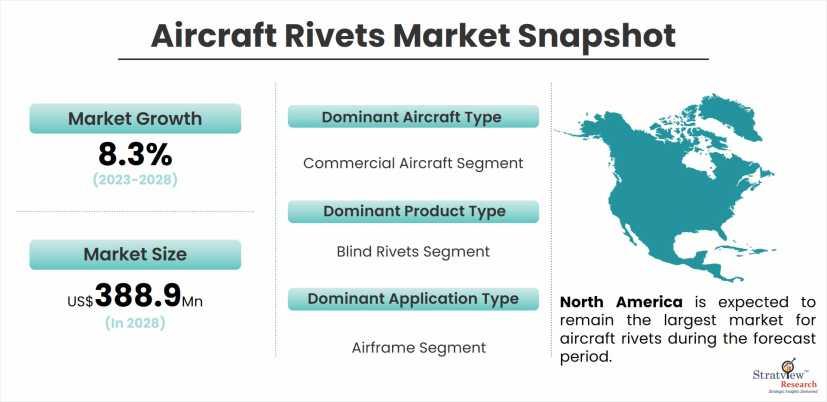The global aircraft rivets market, a vital cog in the aviation industry, is experiencing a period of dynamic transformation. Fueled by the rising demand for air travel and the need for military modernization, the market is expected to witness significant growth in the coming years. However, a closer look reveals diverging trends between the commercial and military segments, driven by distinct priorities and operational requirements. This article delves into the unique characteristics and contrasting trends shaping the demand for aircraft rivets in these two crucial sectors.
Current Market Landscape:
As per Stratview Research, the global aircraft rivets market size is expected reach USD 388.9 billion in 2028, growing at a CAGR of 8.3% during the forecast period of 2023-2028.
Commercial Aviation: A Focus on Efficiency and Passenger Growth
The commercial aviation sector is the primary driver of growth in the aircraft rivets market. Key factors influencing this segment include:
- Rising Air Travel Demand: The increasing demand for air travel, particularly in emerging economies, necessitates a corresponding rise in commercial aircraft production. This translates to a greater requirement for the millions of rivets used in assembling each airplane.
- Focus on Fuel Efficiency: Airlines are constantly striving to reduce operational costs and minimize their environmental footprint. This has led to a growing demand for lightweight materials like composites and aluminum alloys in aircraft construction. Consequently, the demand for rivets compatible with these materials is on the rise.
- Automation and Cost Optimization: Commercial aircraft manufacturers are increasingly adopting automated riveting processes to streamline production lines and enhance efficiency. This trend not only influences the type and volume of rivets required but also necessitates consistent quality to ensure seamless integration with automated systems.
Military Aviation: Prioritizing Durability and Performance
The military aircraft rivets market exhibits a distinct set of trends:
- Modernization Programs: Aging military aircraft fleets around the world are due for replacement and upgradation. This necessitates the use of high-strength, reliable rivets that can withstand the demanding operational environments of military jets, helicopters, and other combat aircraft.
- Emphasis on Durability and Performance: Military aircraft operate under extreme conditions, requiring rivets with exceptional strength, corrosion resistance, and resistance to high temperatures. Specialty materials like titanium and high-performance alloys are often used to meet these stringent requirements.
- Geopolitical Tensions: Periods of heightened geopolitical tensions often lead to increased military spending, which can translate to a surge in demand for military aircraft and consequently, the rivets required for their construction and maintenance.
Diverging Trends in Material Selection:
The choice of materials for aircraft rivets significantly differs between the commercial and military sectors:
- Commercial Aviation:
- Aluminum: Due to its affordability, widespread compatibility, and good strength-to-weight ratio, aluminum rivets remain the dominant choice in commercial aircraft construction.
- Composites: As the use of composite materials like CFRP increases to achieve lighter aircraft structures, the demand for specialized rivets compatible with these materials is growing.
- Military Aviation:
- High-Strength Alloys: Military applications often necessitate rivets made from high-performance alloys like titanium and Inconel. These materials offer superior strength, corrosion resistance, and the ability to withstand extreme temperatures.
- Specialty Rivets: Military aircraft require a wider variety of specialized rivet types to cater to specific applications, such as high-shear and high-tensile strength rivets for critical load-bearing areas.
The Impact of Automation and Aftermarket:
Automation is playing an increasingly significant role in both segments of the aircraft rivets market:
- Commercial Aviation: The commercial sector is at the forefront of adopting automated riveting processes. This necessitates the use of rivets with consistent size and quality for seamless integration with automated systems.
- Military Aviation: While automation is making inroads into the military sector as well, the emphasis remains on human expertise for critical applications and complex riveting tasks.
The aftermarket also presents distinct opportunities in each segment:
- Commercial Aviation: With a larger fleet size and focus on operational efficiency, the commercial sector generates a steady demand for replacement rivets for maintenance, repair, and overhaul (MRO) activities.
- Military Aviation: Military aircraft often have longer operational lifespans compared to commercial airliners. However, the emphasis on maintaining peak performance necessitates the use of high-quality replacement rivets during MRO activities.
